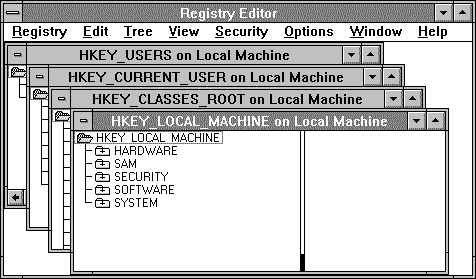
To get the most out of the material in this chapter, you will want to run Registry Editor so that you can see the contents of the Registry for your computer. The Registry Editor application, REGEDT32.EXE, does not appear in any default program groups in Program Manager, but it is installed automatically when you install Windows NT on any computer.
– Or –
Type the start regedt32 command at the command prompt, and press ENTER.
This command will protect the Registry contents while you explore its structure and become familiar with the entries.
For details about security and backup measures to take with the Registry and other issues, see Chapter 11, "Registry Editor and Registry Administration."

Most simply, the Registry is a database, and Registry Editor displays the four subtrees used to access the contents of the database. The hierarchical structure that appears in Registry Editor is similar to how File Manager displays hierarchical directory structures. The information in this chapter will help you understand where specific kinds of information can be found in the Registry (and where you should or should not make changes).
In this chapter, the Registry keys are described in the order they appear in the Registry Editor windows, with a focus on the parts of the Registry where a system administrator might want to view or change entries. Some information is provided merely to explain what is stored in certain keys.
The content or location of a specific Registry key may differ from what is described in this Resource Guide, depending on which services and software are installed, whether a computer is running Windows NT Workstation or Windows NT Server, and other factors. However, the general organization described in this chapter will help you understand how to navigate the Registry.
Note Most Registry entries that you might need to examine or edit are found under HKEY_LOCAL_MACHINE\SYSTEM\CurrentControlSet, described later in this chapter. Specific entries are defined in Chapter 14, "Registry Value Entries."